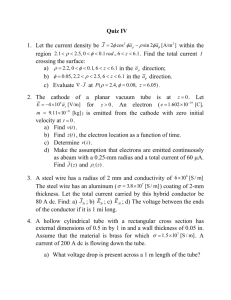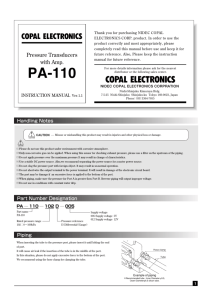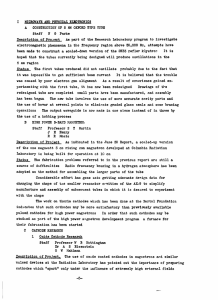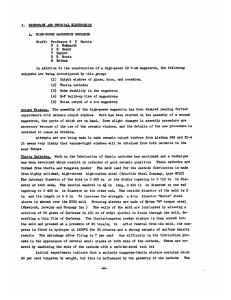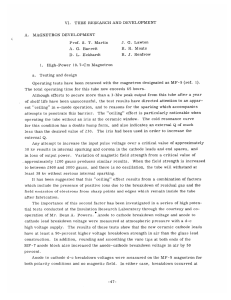I AND PHYSICAL ELECTRONICS J
advertisement
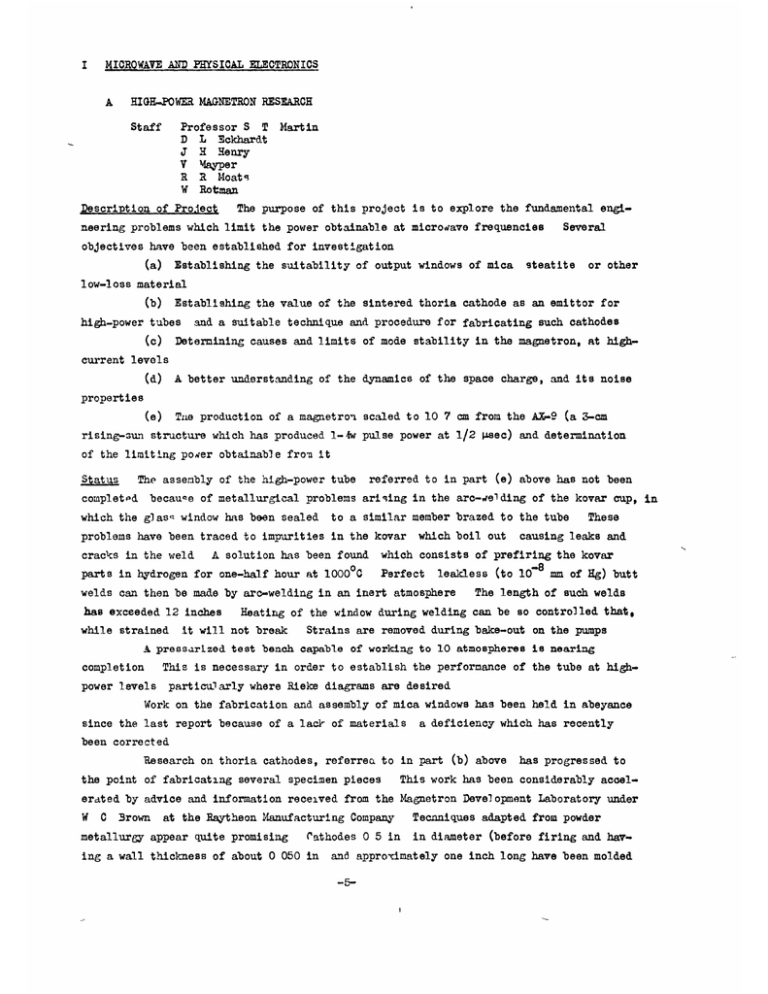
I MICROWAVE AND PHYSICAL ELECTRONICS A HIGH-POWER MAGNETRON RESEARCH Staff Professor S T Martin D L Eckhardt J H Henry V Mayper R R Moat, W Rotman Description of Project The purpose of this project is to explore the fundamental engi- neering problems which limit the power obtainable at microwave frequencies Several objectives have been established for investigation (a) Establishing the suitability of output windows of mica steatite or other low-loss material (b) Establishing the value of the sintered thoria cathode as an emittor for high-power tubes (c) and a suitable technique and procedure for fabricating such cathodes Determining causes and limits of mode stability in the magnetron, at high- current levels (d) A better understanding of the dynamics of the space charge, and its noise (e) Tne production of a magnetroi scaled to 10 7 cm from the AX-9 (a 3-cm properties rising-sun structure which has produced 1-4w pulse power at 1/2 lsec) and determination of the limiting poqer obtainable from it Status The assembly of the high-power tube referred to in part (e) above has not been because of metallurgical problems arising in the arc-delding of the kovar cup, in completed which the glas- window has been sealed to a similar member brazed to the tube problems have been traced to impurities in the kovar cracks in the weld A solution has been found parts in hydrogen for one-half hour at 10000 which boil out while strained causing leaks and which consists of prefiring the kovar Perfect leakless (to 10 - welds can then be made by are-welding in an inert atmosphere has exceeded 12 inches These 8 mm of Hg) butt The length of such welds Heating of the window during welding can be so controlled that, it will not break Strains are removed during bake-out on the pumps A pressarized test bench capable of working to 10 atmospheres is nearing completion This is necessary in order to establish the performance of the tube at highparticularly where Rieke diagrams are desired power levels Work on the fabrication and assembly of mica windows has been held in abeyance since the last report because of a lack of materials a deficiency which has recently been corrected Research on thoria cathodes, referrea to in part (b) above the point of fabricating several specimen pieces has progressed to This work has been considerably accel- erated by advice and information received from the Magnetron Development Laboratory under W 3Brown at the Raytheon Manufacturing Company metallurgy appear quite promising Cathodes 0 5 in ing a wall thickness of about 0 050 in Tecniques adapted from powder in diameter (before firing and hav- and approximately one inch long have been molded from thoria powder, thoria and tungsten, from highly polished high-chrome, and thoria and tungstic oxide The mold is made high-carbon steel (Crucible Steel Company, type HYCO) A mixture of the powder and 3 per cent (by weight) line wax, is pressed at a pressure of 40 tons/sq of carbowax, in a water-soluble crystal- The piece is hydrogen for one-half hour, resulting in a very strong hard ceramic fired at 180000 in Pieces made of pure thoria have a density of 9 2 g/cm3, very nearly the theoretical value The above molding pressure and quantity of lubricant are not sufficient to prevent an undesirable variation in the density in the molded piece (ends are denser than the center), resulting in a variable shrinkage during firing Higher pressures and more lubricant will be tried to remedy this problem Mode separation tests described in on brass models of 1-band magnetron anode blocks as the Progress Report of April 15, 1947, have been completed, and the varia- tion of frequency separation between the T;-mode (n--9) and the n=8 mode as a function of slot widths has been found to be substantially as predicted by field calculations Oscil- loscope patterns showing the detected radial component of the oscillating electric field inside the model anode block as a function of azimuth were studied, and the observed patterns compared with those predicted from field theory By making field computations at a radius approximating the mid-point of the rotating electrostatic probe agreement between the calculated and observed fields was achieved reasonably good Other apparent resonances not corresponding to any known resonance of the model anode were observed, found to be the result detector and of resonances in the coaxial line between the probe and the crystal Such a resonance increases the effective sensitivity of the probe to the point where the distribution of r-f energy in the anode structure at non-resonant frequencies can be observed dork on the causes and limits of mode stabilitj at high currents, referred to in part (c) above has been initiated This will consist of attempting to observe the conditions under which the magnetron shifts operation from the T mode to the next higher voltage mode under steady-state conditions Several 10 7-cm c-w rising-sun anode magnetrous (a), the voltage-scaled equivalents of the high-power magnetron referred to in part are being constructed for this experiment Some exploratory work on the noise properties of the magnetron in its reoscillatine state is being undertaken Its continuation depends on the character of preliminary results B CATHODE RESEARCH 1 Cathode Interface Studies Staff A S Eisenstein Experiments described in the last progress report indicate that when thermionic emission currents are drawn from an oxide cathode, interface and coating gives rise to a voltage, Vic and vacuum surface of the coating the flow of current through the which appears between the base metal Under pulsed conditions this voltage is not negligible as compared to the voltage Va applied between the cathode base metal and the anode -A;- COLLECTOR VOLTAGE Figure 1 10 V -VILOVOLTS KILOVOLTS Retarding potential characteristics 2z Vo - Figure 2 KILOVOLTS Voltage-current Vo chracteristics KILOVOLTS Thus the experimental voltage-current characteristics of a diode show disagreement with the theoretical Langmuir-Child characteristic by a voltage displacement of Vic emission characteristics of cathodes having a Ba 2 The Si04 interface seem to show this effect The actual voltage which appears between the vacuum surface of the coating and the anode (Va ic), may be computed from measurements of the potentials assumed by probes embedded in t'he coating at different depths voltage has been devised A more direct method of determining this Retarding potential measurements are made on electrons which pass through a small hole in the anode and are then collected by a suitable electrode As the cathode of the tube is pulsed negatively the average current which passes through the hole is measured as a function of the d-c retarding potential applied to the collector electrode Typical char.acteristics are seen in Fig conditions shown in Fig and 11 amp/cm 2 2b Curve (1) of Fig 1 for the onerating voltage-current 1 indicates the operating point as 1 81 kv As the collector voltage is made negative and approaches the potential of the coating surface the collected current suddenly drops to a small value of the oxide surface with respect to the anode (Va -Vc) appears from curve (1) to be about 1 44 kv indicating an interface-coating voltage Vic of 375 volts then used as a correction to the applied base metal-anode voltage, resulting characteristic is seen to be in The potential This voltage is Va, Fig 2b The close agreement with the tneoretical Langmuir- Child curve which was computed on the basis of a 0 106-cm anode-rathode spacing The experimental characteristic corresponds to a spacing of 0 110 cm At a higher temperature temperature however, Fig 2c Fig similar results are obtained 2a -oints (9), (10) At a lower -nd (11) no longer agree with the d = 0 110-cm curve and the cathode is operating under non-space charge limited conditions At still lower temperatures values of Vic have been observed up to 850 volts On the basis of Mutter's double-probe experiments which show most of the voltage as appearing across the interface and x--ay measurements of the interface thickness, it seems likely that voltage gradients across the interface may reach 106 volts/cm An interesting and unexpected result of this experiment is the observation that a small number of electrons arrive at the anode with energies up to V be seen in the lower set of curves in Fig these electrons are emitted from cracks in 1 It is a This may presumed that at least part of the coating Further studies of this phenom- ena are under way 2 The Interface as a Blocking Layer Staff W E Mutter No further progress to report at this time 3 \Oonductivity and Worm Functions of Oxide Cathodes Staff G W Mahlman Standard diodes having cathodes of pure nickel (Wise No 1) and single platinum probes embedded in the oxide coating are being made to determine the feasibility of measuring the conductivity of the oxide coating by means of a single probe -8- The pure nickel base metal presumably will not form any appreciable interface, hence a single probe should suffice to determine coating conductivity These experiments are preliminary to an experiment to determine conductivity and photoelectric and thermionic work functions of oxide cathodes 4 The tube for such an experiment is still under construction Spectral Emissivity of Tungsten Staff Professor W B W Z Mutter Nottingham The basic plan of this experiment is described in the progress report of October 15, 1946 The envelope for the tungsten black-body source has been redesigned to facilitate replacement of filaments The original filament, Water cooling has also been provided for the input leads formed from 0 0018 in failure of the expansion joint but this cracked during assembly tungsten foil,buckled on heating because of A second filament was made from sintered tungsten tubing, Filaments are now being made from the original foil, and it is believed that with an improved expansion joint and better filament-forming dies, this type of filament may be operated successfully A compact vacuum tube electrometer setup using the Victoreen VX-41 miniature electrometer tube has been built Although this equipment may be used to some extent in the emissivity work, it will be available for measurement purposes wherever needed Some preliminary tests have been made to estimate the range of wavelengths over which emissivity measurements may be made A 931A photomultiplier circuit designed by Professor Nottingham was used For a given source temperature the long wavelength limit arises from the falling spectral response of the S4 photocathode while on the short wavelength end, the limitation arises primarily from the rapidly decreasing spectral emissive power of the source and the poor transmission of the glass bulbs With a tung0 sten ribbon filament operating at approximately 1600 K and a monochrometer aperture 0 008 in by 0 010 in (bandwidth about 10A in the ultraviolet and 150A in the red) it was found that the emergent light intensity could be measured within 1 per cent at 3500A and at 6300A In spite of the poor response characteristic of the 931A photomultiplier, there is still enough photoelectric current generated from radiation at 8000A to be measured with an accuracy of about 10 per cent Close to the same accuracy is found at the wavelength 3200A The electronic equipment used with the 931A tube for these tests has been developed recently in connection with a project not sponsored by the Research Laboratory of Electronics The performance of the equipment has turned out to be so satisfactory and capable of giving such quantitative measurements at very low levels of light flux are now under way for duplication of the equipment for RLE purposes that a brief description of the equipment is offered here of measurements desired that plans It is for that reason In order to achieve the accuracy extremely stable power supplies are required New circuits using old principles have been designed for a 250-volt supply, a 300-volt supply, and the photomultiplier supply with a range of 250 to 1000 volts The low-voltage supplies have an internal resistance of the order of 1 ohm and the compensation for line voltage variations from 105 to For very slow variations in line voltage, the circuit is 125 volts is practically perfect very slightly over-compensated, while for variations that take place so rapidly that the heaters of the tubes involved do not change temperature appreciably, the circuit is under-compensated pensated at all The high-voltage supply for the 931A tube is slightly practically perfectly com- voltages within the limits specified The indicator system itself calibrated resistors has built into it As a consequence, potentiometers and very accurately accurate measurements can be made over a range of radiation flux values that extends through at least five orders of magnitude the total weight of the equipment as it broken into tnree boxes so that it variety of experiments is now designed is Although approximately 100 pounds, it becomes easily portable and can be used in is a very wide The first application to which the equipment will be made, as soon as the RLE version is completed will be that of the investigation of the spectral emissivity of tungsten 5 Electron Emission in Accelerating and Retarding Fields Staff Professor W B Nottingham C S Hung Although this work has been interrupted for a few months, it is well under way again and a new tube for the investigation of this subject will be available shortly C IONIZATION GAUGE RESEARCH Staff Professor W B Nottingham The ionization gauges of a new design and a conventional design are now on a vacuum system and are being compared over the entire range of pressures suitable for ionization gauge measurements No conclusions have yet been drawn concerning the results of these experiments D PROPERTIES OF CATHODE-RAY TUBE SCREENS Staff Professor W B Nottingham W T Pyall The specialized equipment referred to in the April 15 Progress Report has now been reconnected and is practically ready for operation As soon as the preliminary standardization runs have been made it is anticipated that a full-time program will be carried on for the next quarter for the evaluation of special properties of cathode-ray tube screens E DETERMINATION OF EMISSION PROPERTIES OF SINGLE CRYSTALS Staff Professor W B Nottingham C J Marcinkowski M K Wilkinson The work on the above subject has been temporarily discontinued, but will be renewed actively sometime in October -10- I F CONSTRUCTION OF 5-MM OXFORD TYPE TUBE Staff N G Parke Experiments on the version of the 60,000-Me reflex velocity-modulated tube discussed in the last progress report showed conclusively that with proper gun alignment it was possiole to get almost all of the beam current through the 14-mil reentrant gap in the cavity However all three tubes tested showed a rapid fall-off in beam current dur- ing the three-hour period required to bring the beam voltage up to its operating value The most reasonable explanation for this was the fact that the tube had a ground-glass seal using stopcock grease As a result, when the This precluded a 45000 bake-out the gas coming out of the bottom electrode of the beam voltage exceeded 1200 volts Thus none cavity contributed to a destructive positive-ion bombardment of the cathode oscillafor current starting 4-ma estimated the of the three tubes was able to reach the tube has been completely redesigned and has To overcome these difficulties, tion assumed a less engineered and more experimental appearance The new design has the following interesting features (1) The gun may be aligned during operation by three thermal aligning struts (2) The cavity is thermally tuned by a single strut (3) The reflector is hollow and positioned by a small ceramic sleeve (4) The gun is positioned by an accurate Jig while being spot-welded to the aligning mechanism (5) The whole mechanism is enclosed in a 2" x 7" glass envelope and will be baked out as long as necessary at 45000 Parts for five tubes have been completed and the assembly of one tube is nearl7 coz2lete G TRAVELING-.AVE AMPLIFIER TUBES 1 Theoretical Considerations Dr L J Chu J D Jackson Staff A paper under the title "Field Theory of Traveling-6ave Tubes" recently as RLE Technical Report No Electron Tube Conference at Syracuse 38 The material was presented at the I R E and the Second Annual Congress of the New York Canadian Association of Professional Physicists, London For a narrow beam Ontario it has been shown in this report that the a-c convection cur- rent bears a linear relationship with the axial electric field E M 0 I = 0 where I o is the d-c beam current v 0 is the d-c electron velocity Y = was published a + J0, the propagation constant The rate of increase of power along the tube is equal to the time average of the product can be equated to -aZ 2which /Z where Z is the ratio of 2P/Ef E cubic equation (M +-22 (a2 + 2)I cmAL°-3 The result is a = 0 vo where ap = - f/vrom this equation, we get 0 2 1 0 0 I 2 = The maximum value of a2 is obtained by differentiating 2 with respect to ap, assuming that Z and v o are constant 1 max 2 2m V This is the formula obtained by Pierce and Kompfner 2 Experimental Studies Staff Professor J B L A Harris Description of Project Wiesner The purpose of this project is to build traveling-wave tubes for X-band operation, and to study their characteristics Status Of these Several tubes have been constructed since publication of the last progress report one tube had a very small gain when used on S-band This gain, however, was much smaller than the cold insertion loss, so that there was no net gain A study of the problem of coupling energy from the waveguide to the helix indicates that the waveguide holes through which the tube projects must be made much With the present size of hole used a considerable radiation takes place and the presence of the glass envelope aggravates this situation smaller The other factor which prevents the tube from operating as desired is the lack of sufficient beam current along the axis of the helix Because the helix and tube must be made smaller, and because the beam current must be increased considerably, efforts will be directed principally at producing an electron gun which will meet these requirements Once this is achieved, it appears likely that the traveling-wave tube may be made to function with reasonable success -12-
